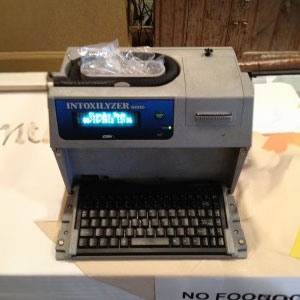
Most people charged with a DUI in Philadelphia believe that there is no way to win. This feeling may especially be the case when the alleged breath test readings are high. However, the truth of the matter is that Philadelphia’s breath test machine, the Intoxilyzer 8000, is not fool proof. And high
breath readings do not mean much, when they are wrong. Mistakes can be made, not only by the
operators of the device, but by the device itself when calculating a breath test result.
Human Errors
In 2011, it was discovered that over a thousand DUI prosecutions and convictions were in jeopardy because of the multiple mistakes made by an individual responsible for calibrating the Philadelphia Police Department’s breath test devices. http://seattletimes.nwsource.com/html/nationworld/2014578514_apusbungledbreathalyzer.html. These mistakes were simple ones that should have never been made by a properly trained breath machine operator.
When an Intoxilyzer 8000 operator tests a DUI suspect, he has the responsibility to follow a number of basic steps to ensure that the breath results are accurate. First, the operator needs to make sure that electronic devices are removed from the breath testing room. Second, the operator must watch the person arrested for 20 minutes prior to taking the first breath sample. This task is to ensure the individual does not put food or liquid in his mouth or belch. Finally, the operator must take two breath test samples that are within .020 agreement of each other.If any one of these requirements is not met, then the breath test results cannot be used against a driver accused of DUI.
Machine Error
Supposing the breath test operator does everything properly, the Intoxilyzer 8000 can still miscalculate a person’s breath alcohol concentration (BrAC). Common food items, like bread or pizza dough, contain yeast that produces a low amount of alcohol (EtOH). When a person blows into the device with this type of food in his or her mouth, the Intoxilyzer will detect alcohol in the breath sample. This type of alcohol is different than that in a person’s blood stream and does not affect driving abilities.
Certain conditions, such as gastroesophageal reflux disease (GERD), can cause a person to inadvertently regurgitate the contents of his or her stomach. Alcohol from a person’s stomach, when refluxed, will then be in the same airway where a person expels air for breath testing. In this instance, the raw alcohol from the stomach will cause a falsely elevated breath test reading.Illness that causes a person to have an abnormally high body temperature will also elevate breath test readings. The Intoxilyzer 8000 does not have a built-in temperature sensor for breath samples.
Therefore, the device cannot tell if a person has a fever. Studies have shown that for every one degree Celsius a person’s body temperature is elevated, the breath test readings will falsely be elevated by 6%. So, if you have a fever of 104 degrees, the breath test reading will be 18% higher than without a fever.
My Training
I have been trained to operate a number of breath testing machines, including the Intoxilyzer 8000. Yes, that means I have used the device to test people who drank alcohol. I have done calibration and accuracy checks on the device. I have tried to fool the machine in a number of different ways. At times, I succeeded; other times, I failed. However, what I have discovered is that no breath test device is perfect. As such, breath test results are not always reliable. The important part of approaching a DUI case is to understand all of the ways the operators and breath test machines can make mistakes. Then those mistakes have to be attacked in every way possible.
Request A Consultation For
NJ DWI Call: (856) 429-2323
PA DUI Call: (215) 496-9292